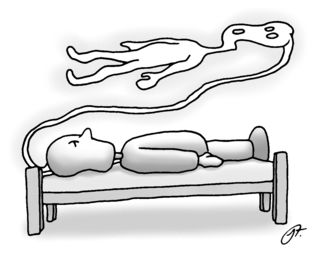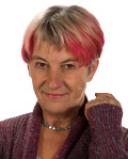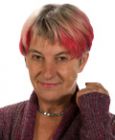Parapsychology
Out-of-Body Experiences: All OBEs Are Natural Phenomena
Part 14: Are there "real" OBEs as well as those explained by science?
Posted October 10, 2019 Reviewed by Kaja Perina
Nearing the end of this series on out-of-body experiences (OBEs), I know that many readers disagree with my conclusion. I believe that these experiences, in which we seem to travel beyond our physical body, are best explained as distortions of, or changes to, the body schema. I have enjoyed many comments from readers, including some tough arguments against this conclusion. So I want to raise one last possibility that some people might find tempting.
Could it be that OBEs like mine are hallucinations that only seem like real OBEs, while there are others that are the real thing? That is, perhaps there are two types—brain-based as well as "real" OBEs in which a spirit, soul, or astral body separates from the physical body and can exist without it?
I am not here addressing the fraught topic of claims for accurate perception at a distance during OBEs. If these are valid, they would force new theories, but most such claims relate to near-death experiences and are highly contentious (I may turn to this important topic later if you readers are keen). Instead, I want to ask whether the classic cases of astral projection, going back to the start of that idea, look like body schema distortions or not.
Let’s look at the most famous "astral travelers," such as Robert Monroe, Sylvan Muldoon, Oliver Fox, and Yram. Their wonderful adventures captivated me when I first studied astral projection in the 1970s. Do these terrific accounts have telltale features of bodily distortions, or do they sound like something completely different—mysterious and supernatural—evidence for consciousness beyond the body?
"Oliver Fox" (a pseudonym of the journalist Hugh George Callaway) became famous in the 1920s for his classic book Astral Projection, which describes a lifetime of explorations into lucid dreaming and OBEs, and the methods he discovered for inducing them. He describes a miserable childhood of illness, frequent nightmares, and frightening apparitions.
Most interesting here is that he especially feared moments in which he might be occupied in some normal activity when things would "go wrong." He felt briefly paralyzed and found that everything around him seemed to "separate and stretch" his body. Although his accounts are part of the classic literature of astral projection, he was clearly experiencing bodily distortions from the very start. His paralysis means the body schema is failing to control his movements, and the stretching is a typical body distortion that can be induced by stimulating the TPJ (temporoparietal junction).

Another well-known astral traveler was Sylvan Muldoon, who teamed up with psychical researcher Hereward Carrington to write two famous books; the first, The Projection of the Astral Body (1929), was about his own many experiences, starting when he was 12 years old. He describes waking in the middle of the night, unable to move.
Muldoon called this "astral catalepsy," but it was presumably what we now know as "sleep paralysis." He felt a sensation of floating, a rapid up-and-down vibration, and a tremendous pressure in the back of his head, before finding himself floating above his bed and being pulled up to vertical.
Many of the features Muldoon described, especially the floating and pulling sensations, are clearly related to changes in body schema. As we have seen, both can be induced by stimulating the temporoparietal junction (TPJ). He had muscle twitches and jerks, which we now know as the common experience of myoclonus, or myoclonic jerks, often experienced on the verge of sleep.
Yram (this one is a pseudonym of a French occultist) is another of the early astral projectors. Unlike Fox, he claims good health is required for successful projection, but he also describes vestibular and bodily sensations. On one occasion, he felt he was falling, as though through a trapdoor; on others, he seemed to be spiraling out of his body as though in a whirlwind. Like other astral adventurers, he described other worlds, different levels of "vibration," and he assumed he was traveling on the astral planes.
More recently came Robert Monroe, well-known for his books (1971, 1985) and for the Monroe Institute, where people can go to learn how to have OBEs and induce other altered states of consciousness. His own adventures began when he was lying down for a rest one afternoon. A beam of light seemed to come out of the sky, and his body began to shake and vibrate. He progressed to have many OBEs and, like Yram, describes the different worlds and three levels that he visited during his astral travels.
Monroe’s method for inducing OBEs is possibly the most well-known and is taught at his Institute. The first step is to induce the "vibrational state." This may involve not just bodily vibrations but sensations of surging, hissing, and pulsating rhythms. I have tried these methods, and many others, and can reasonably reliably induce the vibrations and floating sensations, if rarely the OBE itself.
Once this is achieved, you are meant to imagine floating upwards or use the "rotation method," imagining twisting, rolling over, and then floating upwards. So what are these vibrations, so common in accounts of astral projection? They may, of course, be vibrations of the astral body as it prepares to separate from the physical, but to me, they sound like an unstable body schema: a result of the brain trying and failing to re-establish a coherent body representation as it flips back and forth.
Finally, I’ll mention Robert Bruce, or AstralBob, whose Astral Dynamics book (1999) and popular website also promote an induction method, starting with deep relaxation leading to vibrations. Once you have achieved the vibrations and practiced controlling them, you imagine a rope reaching up above your body and mentally climb this rope, pulling yourself up with imagined hands. This makes sense as a method for inducing the sensation of leaving the body. Deep relaxation, and the disorientating sounds used in his training, loosen the body schema, and the rope method encourages its manipulation.
There are many other methods (I’ve described them in more detail in my 2017 book), but the point I want to illustrate here is how often they seem to be exactly what you would need to do to disrupt your own body schema. The brain’s job, in constructing its body schema, is to keep you firmly in touch with the real world around you. Located primarily in the TPJ, it takes input from all the senses, memory, and emotions, and keeps track of where your limbs are and every movement you make.
Disrupting it is obviously not a good idea. You could not sit up or walk across the room, let alone run and jump, without an accurate and rapidly updated body schema. So it makes sense that you have to go through some complicated procedures to split the body schema in two and achieve an OBE. This is what I think is happening with the famous vibrations. The would-be astral traveler is trying to get the schema to split; their brain’s natural processes are trying to prevent it.
My answer to my own question is this: The most famous astral travelers all describe floating, falling, and bodily distortions likely to be caused by disruption to the body schema. The best-known methods of inducing OBEs entail inducing vibrations and imagining moving and floating in a second body. My own OBE included very similar sensations. So, personally, I see no need to think there are two kinds of OBE—the "real" sort in which an astral body really does leave, and the kind I have written about in all these posts.
In other words, all OBEs are perfectly natural phenomena.
References
Blackmore, S. 2017 Seeing Myself: The new science of out-of-body experiences, London, Robinson
Bruce, R. 1999 Astral Dynamics: A new approach to out-of-body experiences. Newburyport, Mass., Hampton Roads
Fox, O. n.d. Astral Projection, London, Rider & Co.
Monroe,R.A. 1971 Journeys Out of the Body. New York, Doubleday.
Monroe, R.A. 1985 Far Journeys, London, Souvenir Press
Muldoon,S. and Carrington,H. 1929 The Projection of the Astral Body, London, Rider & Co.
Yram 1935 Practical Astral Projection (translated from the French Le Medecin de L’Ame, London, Rider




